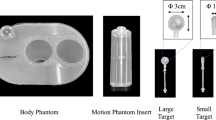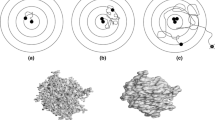Abstract
Dynamic magnetic resonance imaging (MRI) is emerging as the elected image modality for organ motion quantification and management in image-guided radiotherapy. However, the lack of validation tools is an open issue for image guidance in the abdominal and thoracic organs affected by organ motion due to respiration. We therefore present an abdominal four-dimensional (4D) CT/MRI digital phantom, including the estimation of MR tissue parameters, simulation of dedicated abdominal MR sequences, modeling of radiofrequency coil response and noise, followed by k-space sampling and image reconstruction. The phantom allows the realistic simulation of images generated by MR pulse sequences with control of scan and tissue parameters, combined with co-registered CT images. In order to demonstrate the potential of the phantom in a clinical scenario, we describe the validation of a virtual T1-weighted 4D MRI strategy. Specifically, the motion extracted from a T2-weighted 4D MRI is used to warp a T1-weighted breath-hold acquisition, with the aim of overcoming trade-offs that limit T1-weighted acquisitions. Such an application shows the applicability of the digital CT/MRI phantom as a validation tool, which should be especially useful for cases unsuited to obtain real imaging data.








Similar content being viewed by others
Explore related subjects
Discover the latest articles, news and stories from top researchers in related subjects.References
Aja-Fernandez S, Cordero-Grande L, Alberola-Lopez C. (2012) A MRI phantom for cardiac perfusion simulation. In: IEEE ISBI, pp 638–641
Axel L (1984) Blood flow effects in magnetic resonance imaging. AJR Am J Roentgenol 143(6):1157–1166
Benoit-Cattin H, Collewet G, Belaroussi B et al (2005) The SIMRI project: a versatile and interactive MRI simulator. J Magn Reson 173:97–115
Bernstein MA, Kevin FK, Xiaohong JZ (2004) Handbook of MRI pulse sequences. Elsevier Academic Press, p 961. ISBN:978-0-12-092861-3
Bettinardi V, Picchio M, Di Muzio N et al (2010) Detection and compensation of organ/lesion motion using 4D-PET/CT respiratory gated acquisition techniques. Radiother Oncol 96:311–316
Boye D, Lomax T, Knopf A (2013) Mapping motion from 4D-MRI to 3D-CT for use in 4D dose calculations: a technical feasibility study. Med Phys 40:061702
Brix L, Ringgaard S, Sørensen TS et al (2014) Three-dimensional liver motion tracking using real-time two-dimensional MRI. Med Phys 41:042302
Cai J, Chang Z, Wang Z et al (2011) Four-dimensional magnetic resonance imaging (4D-MRI) using image-based respiratory surrogate: a feasibility study. Med Phys 38:6384–6394
Carrillo A, Duerk JL, Lewin JS et al (2000) Semiautomatic 3-D image registration as applied to interventional MRI liver cancer treatment. IEEE Trans Med Imaging 19:175–185
Chirindel A, Adebahr S, Schuster D et al (2015) Impact of 4D-18FDG-PET/CT imaging on target volume delineation in SBRT patients with central versus peripheral lung tumors. Multi-reader comparative study. Radiother Oncol 115:335–341
Dean CJ, Sykes JR, Cooper RA et al (2012) An evaluation of four CT–MRI co-registration techniques for radiotherapy treatment planning of prone rectal cancer patients. Br J Radiol 85:61–68
Deng Z, Pang J, Yang W et al (2016) Four-dimensional MRI using three-dimensional radial sampling with respiratory self-gating to characterize temporal phase-resolved respiratory motion in the abdomen. Magn Reson Med 75:1574–1585
Deoni SC, Rutt BK, Peters TM (2003) Rapid combined T1 and T2 mapping using gradient recalled acquisition in the steady state. Magn Reson Med 49:515–526
Deoni SC, Kost JA, Adams PA et al (2004) Quantification of liver iron with rapid 3D R1 and R2 mapping with DESPOT1 and DESPOT2. Proc Int Soc Magn Reson Med 11:889
Elmaoğlu M, Çelik S (2012) MRI handbook: MR physics, patient, positioning, and protocols. Springer, Berlin
Fallone BG (2014) The rotating biplanar linac-magnetic resonance imaging system. Semin Radiat Oncol 24:200–202
Fayad H, Schmidt H, Wuerslin C et al (2015) Reconstruction-incorporated respiratory motion correction in clinical simultaneous PET/MR imaging for oncology applications. J Nucl Med 56:884–889
Fuchs F, Laub G, Othomo K (2003) TrueFISP - technical considerations and cardiovascular applications. Eur J Radiol 46:28–32
Gianoli C, Riboldi M, Spadea MF et al (2011) A multiple points method for 4D CT image sorting. Med Phys 38:656–667
Gianoli C, Riboldi M, Fontana G et al (2013) Optimized PET imaging for 4D treatment planning in radiotherapy: the virtual 4D PET strategy. Technol Cancer Res Treat 14(1):99–110
Griswold MA, Jakob PM, Heidemann RM et al (2002) Generalized autocalibrating partially parallel acquisitions (GRAPPA). Magn Reson Med 47:1202–1210
Haase A (1990) Snapshot flash MRI: applications to T1, T2, and chemical-shift imaging. Magn Reson Med 13:77–89
Jurczuk K, Kretowski M, Bellanger JJ et al (2013) Computational modeling of MR flow imaging by the lattice Boltzmann method and Bloch equation. Magn Reson Imaging 7:1163–1173
Keall P, Barton M, Crozier S (2014) The Australian magnetic resonance imaging-linac program. Semin Radiat Oncol 24:203–206
Kim J, Glide-Hurst C, Doemer A et al (2015) Implementation of a novel algorithm for generating synthetic CT images from magnetic resonance imaging data sets for prostate cancer radiation therapy. Int J Radiat Oncol Biol Phys 91:39–47
Lagendijk JJW, Raaymakers BW, van Vulpen M (2014) The magnetic resonance imaging-linac system. Semin Radiat Oncol 24:207–209
Lamare F, Fayad H, Fernandez P et al (2015) Local respiratory motion correction for PET/CT imaging: application to lung cancer. Med Phys 42:5903–5912
Lange T, Wenckebach TH, Lamecker H et al (2005) Registration of different phases of contrast-enhanced CT/MRI data for computer assisted liver surgery planning: evaluation of the state-of-the-art-methods. Int J Med Robot Comput Assist Surg 1:6–20
Liu F, Kijowski R, Block W (2014) Performance of multiple types of numerical MR simulation using MRiLab. Proc Int Soc Magn Reson, Med, p 5244
Maintz JBA, Viergever MA (1998) A survey of medical image registration. Med Image Anal 2:1–36
Moore JA, Steinman DA, Holdsworth DW et al (1999) Accuracy of computational hemodynamics in complex arterial geometries reconstructed from magnetic resonance imaging. Ann Biomed Eng 27:32–41
Mutic S, Dempsey JF (2014) The viewray system: magnetic resonance-guided and controlled radiotherapy. Semin Radiat Oncol 24:196–199
Nyman R, Ericsson A, Hemmingsson A et al (1986) T1, T2, and relative proton density at 0.35 T for spleen, liver, adipose tissue, and vertebral body: normal values. Magn Reson Med 3:901–910
Paganelli C, Peroni M, Riboldi M et al (2013) Scale invariant feature transform in adaptive radiation therapy: a tool for deformable image registration assessment and re-planning indication. Phys Med Biol 58:287–299
Paganelli C, Summers P, Bellomi M et al (2015) Liver 4DMRI: a retrospective image-based sorting method. Med Phys 8:4814–4821
Paganelli C, Seregni M, Fattori G et al (2015) Magnetic resonance imaging-guided versus surrogate-based motion tracking in liver radiation therapy: a prospective comparative study. Int J Radiat Oncol Biol Phys 91:840–848
Paradis E, Cao Y, Lawrence TS et al (2015) Assessing the dosimetric accuracy of magnetic resonance-generated synthetic CT images for focal brain VMAT radiation therapy. Int J Radiat Oncol Biol Phys 93:1154–1161
Parodi K (2015) Vision 20/20: positron emission tomography in radiation therapy planning, delivery, and monitoring. Med Phys 42:7153
Perrin R, Peroni M, Bernatowicz K (2014) A realistic breathing phantom of the thorax for testing new motion mitigation techniques with scanning proton therapy. Med Phys 41:111
Plathow C, Ley S, Fink C et al (2004) Analysis of intrathoracic tumor mobility during whole breathing cycle by dynamic MRI. Int J Radiat Oncol Biol Phys 59:952–959
Plathow C, Klopp M, Fink C et al (2005) Quantitative analysis of lung and tumour mobility: comparison of two time-resolved MRI sequences. Br J Radiol 78:836–840
Rit S, van Herk M, Zijp L et al (2012) Quantification of the variability of diaphragm motion and implications for treatment margin construction. Int J Radiat Oncol Biol Phys 82:399–407
Rofsky NM, Lee VS, Laub G et al (1999) Abdominal MR imaging with a volumetric interpolated breathhold examination. Radiology 212:876–884
Sauter AW, Schwenzer N, Divine MR et al (2015) Image-derived biomarkers and multimodal imaging strategies for lung cancer management. Eur J Nucl Med Mol Imaging 42:634–643
Sawant A, Keall P, Pauly KB et al (2014) Investigating the feasibility of rapid MRI for imageguided motion management in lung cancer radiotherapy. BioMed Res Int. doi:10.1155/2014/485067
Segars P, Sturgeon G, Mendonca S et al (2010) 4D XCAT phantom for multimodality imaging research. Med Phys 37:4902–4915
Shackleford J, Kandasamy N, Sharp GC (2010) On developing B-spline registration algorithms for multi-core processors. Phys Med Biol 55:6329–6351
Sharif B, Bresler Y (2014) Adaptive real-time cardiac MRI using PARADISE: validation by the physiologically improved NCAT phantom. Proc IEEE Int Symp Biomed Imaging. doi:10.1109/ISBI.2007.357028
Tryggestad E, Flammang A, Han-Oh S et al (2013) Respiration-based sorting of dynamic MRI to derive representative 4D-MRI for radiotherapy planning. Med Phys 40:051909
Tryggestad E, Flammang A, Hales R et al (2013) 4D tumor centroid tracking using orthogonal 2D dynamic MRI: implications for radiotherapy planning. Med Phys 40:091712
von Siebenthal M, Székely G, Gamper U et al (2007) 4D MR imaging of respiratory organ motion and its variability. Phys Med Biol 52:1547–1564
Weon C, Hyun Nam W, Lee D et al (2015) Position tracking of moving liver lesion based on real-time registration between 2D ultrasound and 3D preoperative images. Med Phys 42:335–345
Wissmann L, Santelli C, Segars P et al (2014) MRXCAT: realistic numerical phantoms for cardiovascular magnetic resonance. J Cardiovasc Magn Reson 16:63
Quasar. http://modusmed.com/qa-phantoms/mri-respiratory-motion
Yang J, Cai J, Wang H et al (2014) Four-dimensional magnetic resonance imaging using axial body area as respiratory surrogate: initial patient results. Int J Radiat Oncol Biol Phys 88:907–912
Yang YX, Teo SK, Van Reeth E et al (2015) A hybrid approach for fusing 4D-MRI temporal information with 3D-CT for the study of lung and lung tumor motion. Med Phys 48:4484–4496
Yu JI, Kim JS, Park HC et al (2013) Evaluation of anatomical landmark position differences between respiration-gated MRI and four-dimensional CT for radiation therapy in patients with hepatocellular carcinoma. Br J Radiol 86:1–7
Acknowledgements
This work was partially supported by AIRC, the Italian Association for Cancer Research. The author would also like to thank A. Pifferi for the help during tissue parameter estimation and G. Buizza and S. Cacciatore for the rigid registration assessment.
Author information
Authors and Affiliations
Corresponding author
Rights and permissions
About this article
Cite this article
Paganelli, C., Summers, P., Gianoli, C. et al. A tool for validating MRI-guided strategies: a digital breathing CT/MRI phantom of the abdominal site. Med Biol Eng Comput 55, 2001–2014 (2017). https://doi.org/10.1007/s11517-017-1646-6
Received:
Accepted:
Published:
Issue Date:
DOI: https://doi.org/10.1007/s11517-017-1646-6




